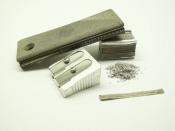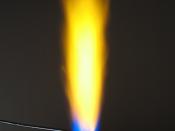Experiment to Determine the order of Reactivity for a given set of Metals
Prediction
I predict that the order of reactivity for the given set of metals will be Sodium, Magnesium, Zinc, Iron, and Copper. With copper being the least reactive.
The Reason for my Prediction
Iron is used for ships hulls and nails so it can't be very reactive. Copper is used in electrical equipment so that too can't be very reactive. And sodium reacts very violently with water so that is very reactive and magnesium can't be as reactive as sodium.
Apparatus and Reactunts
Samples of: Zinc foil, Copper foil, Magnesium ribbon, Sodium and iron nails.
Solutions of : Zinc chlorine, Copper chlorine, Magnesium chlorine, Sodium chlorine, Iron chlorine.
Equipment : Test tubes, Test tube racks, Dropping pipettes, Tongs, Tweezers, Scalpel, Measuring cylinder.
Method
1.Take 4 of the materials and use 4 of the 5 solutions (exclude the metal which is the same as one of the materials)
2.For all the metals (except sodium which requires an adult to perform) place them in a small amount of the liquid with the tweezers and record the reaction. If a reaction has taken place there will either be a change of colour or bubbles coming out (gasses give off). Make sure to use the same amount of liquid for each test using the measuring cylinder.
3.For sodium get your teacher to get a beaker and drop a v.small amount of sodium into it.
4.Record all the results on a table.
Fair Test
I will make this a fair test by using the same amount of liquid in each container and the same amount of pieces of foil in each one.
A Reliable Test
It is only reliable if you use the right and same...


